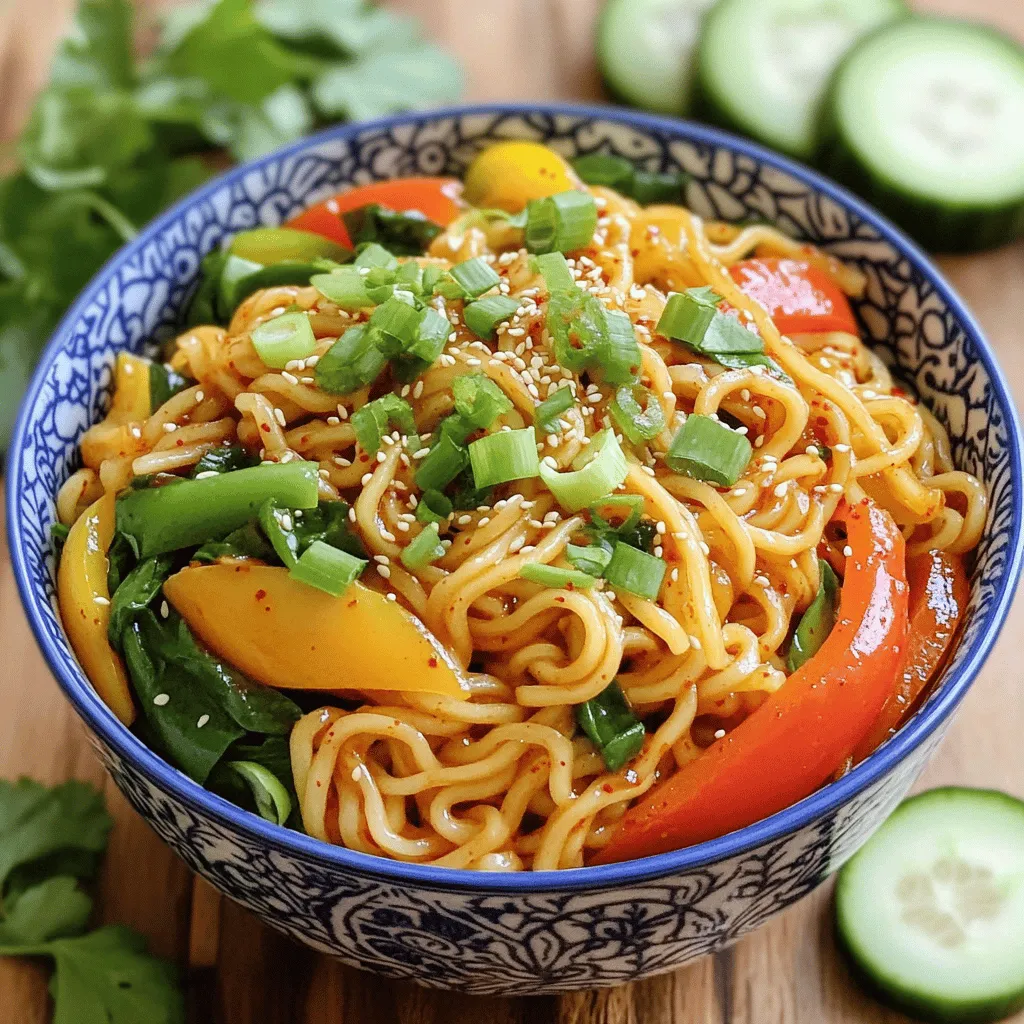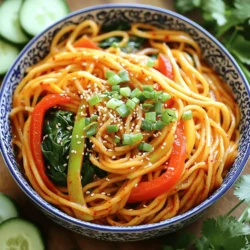If you’re craving a dish that bursts with flavor, Korean Gochujang Noodles are your answer! This recipe is simple but packs a punch. With just a few ingredients, you will create a comforting bowl that highlights the rich, spicy taste of gochujang. Whether you’re a busy parent or just want an easy dinner, this quick recipe is perfect for you. Let’s dive in and whip up this delicious meal together!
Ingredients
Main Ingredients for Korean Gochujang Noodles
– 200g noodles (your choice – udon, soba, or rice noodles)
– 2 tablespoons gochujang (Korean chili paste)
– 1 tablespoon sesame oil
Additional Flavorings
– 1 tablespoon soy sauce
– 1 tablespoon honey or maple syrup
– 2 cloves garlic, minced
Vegetables and Garnishes
– 1 cup mixed bell peppers, thinly sliced
– 1 cup baby spinach
– 2 green onions, chopped
– Optional: sliced cucumber and cilantro
When making Korean gochujang noodles, I love using fresh ingredients. The type of noodles you choose is key. Udon gives a chewy bite, while soba offers a nutty flavor. Rice noodles are light and great for a gluten-free option.
Gochujang is the star of this dish. It packs a spicy punch and has a hint of sweetness. The sesame oil adds a rich, nutty taste. A mix of soy sauce and honey balances the heat with sweetness.
Fresh vegetables are important, too. Bell peppers add color and crunch. Baby spinach wilts down nicely and brings a healthy touch. Green onions give brightness and a mild onion flavor.
You can also add sliced cucumber and cilantro for extra freshness. These garnishes not only look nice but also enhance the taste.Enjoy crafting this flavor-packed dish!
Step-by-Step Instructions
Cooking the Noodles
To boil the noodles correctly, follow these steps:
1. Fill a pot with water and add salt. Use about one tablespoon of salt for a big pot.
2. Bring the water to a rolling boil. This helps cook the noodles evenly.
3. Add your noodles. Cook them according to the package instructions until they are al dente.
4. Drain the noodles in a colander. Rinse them under cold water for a few seconds. This stops the cooking process.
To prevent your noodles from becoming sticky, follow these tips:
– Stir the noodles gently while cooking. This keeps them from clumping.
– Make sure to rinse them well after draining. Cold water washes away extra starch.
– Toss the drained noodles with a tiny bit of oil if you’re not using them right away.
Preparing the Gochujang Sauce
For the sauce, gather these ingredients:
– 2 tablespoons gochujang
– 1 tablespoon sesame oil
– 1 tablespoon soy sauce
– 1 tablespoon honey or maple syrup
– 2 cloves garlic, minced
– 1 teaspoon grated ginger
To mix the sauce smoothly, do this:
1. Place all the ingredients in a bowl.
2. Use a whisk or fork to blend them well. The sauce should be smooth and creamy.
Sautéing the Vegetables
For stir-frying, you need the right temperature:
– Heat your skillet or wok over medium-high heat. This helps the veggies cook fast and stay crisp.
To achieve tender-crisp bell peppers, use these tips:
– Cut the bell peppers into thin slices. This helps them cook quickly.
– Stir-fry for about 3-4 minutes. They should be bright and slightly soft but still crunchy.
Combining and Serving
To mix the noodles and sauce properly, follow these steps:
1. Add the cooked noodles to your skillet with the sautéed vegetables.
2. Pour the gochujang sauce over the noodles.
3. Toss everything gently for 2-3 minutes. Make sure all the noodles are coated well.
For serving suggestions, try this:
– Serve the noodles in bowls.
– Garnish with chopped green onions and sesame seeds. You can also add sliced cucumber and fresh cilantro for extra flavor.
Tips & Tricks
Perfecting the Recipe
To make your Korean gochujang noodles shine, focus on these key techniques:
– Use fresh ingredients: Fresh veggies bring color and flavor.
– Cook noodles al dente: This keeps them firm and helps them hold sauce better.
– Whisk the sauce well: Mix gochujang, sesame oil, and other ingredients until smooth for even flavor.
Common mistakes to avoid include:
– Overcooking the noodles: This makes them mushy and unappetizing.
– Skipping the rinse: Rinsing stops the cooking process and prevents stickiness.
– Not tasting as you go: Adjust flavors to suit your taste.
Spice Level Adjustments
You can customize the heat of your dish easily. To lower the spice level:
– Use less gochujang: Start with one tablespoon instead of two.
– Add ingredients like coconut milk: This helps cool down the heat.
– Mix in more veggies: Extra bell peppers or spinach can balance the spice.
For a milder version, consider these alternative ingredients:
– Sriracha: It still offers heat, but with a different flavor.
– Chili paste: Look for a milder variety at the store.
Cooking Tools
The right tools make cooking easier and faster. Here are my top picks:
– Large Skillet or Wok: Essential for stir-frying veggies and noodles evenly.
– Whisk: A good whisk helps you mix sauces quickly and smoothly.
– Tongs: Perfect for tossing everything together without breaking the noodles.
Having a good skillet or wok is key. It distributes heat well and helps achieve that tasty, slightly charred flavor. Using the right tools can turn cooking into a fun and quick experience.

Variations
Vegan and Gluten-Free Options
You can easily make this dish vegan and gluten-free. To do this, you can swap gochujang for vegan soy sauce. This change keeps the flavor and makes it plant-based. For gluten-free noodles, choose rice noodles or gluten-free pasta. These options maintain the texture while keeping it safe for those with gluten issues.
Protein Additions
Adding protein makes this dish even better. You can include chicken, tofu, or shrimp for extra flavor and nutrition. If you use chicken, cut it into small pieces and cook it first. For tofu, use firm tofu and cube it. Sauté it until golden. If you choose shrimp, cook them until they turn pink. This only takes a few minutes. Adding protein gives you a full meal in one bowl.
Unique Flavor Profiles
To make your noodles unique, consider adding kimchi or mushrooms. Kimchi brings a spicy and tangy flavor that pairs well with gochujang. Mushrooms add depth and umami. You can also explore regional variations of Korean noodle dishes. Each region has its own twist on flavors and ingredients. This allows you to customize your noodles to suit your taste.
Storage Info
Storing Leftovers
To keep your Korean gochujang noodles fresh, use airtight containers. Glass or plastic containers work great. Make sure to cool the noodles before sealing. In the fridge, your leftovers last about 3 to 4 days. If you want to save them longer, freeze them. In the freezer, they stay good for up to 2 months. Just remember to label your container with the date.
Reheating Noodles
When reheating, you want to keep the noodles tender. The best way is to use the stovetop. Heat a splash of oil in a pan, then add the noodles. Stir them gently until warm. You can also use the microwave, but be careful. Heat them in short bursts. Stir in between to avoid hot spots. This way, your noodles stay smooth and tasty.
FAQs
What is Gochujang?
Gochujang is a Korean chili paste. It has a rich, spicy, and slightly sweet flavor. The main ingredients are red chili powder, glutinous rice, fermented soybeans, and salt. This mix gives gochujang its unique taste. It adds depth and warmth to many dishes.
Nutritionally, gochujang is low in calories but packs a punch with flavor. It contains some carbohydrates and protein. The fermentation process also gives it healthy probiotics. Each tablespoon has about 30 calories, making it a flavorful addition without many extra calories.
Can I use other sauces instead of gochujang?
Yes, you can use other sauces. For a similar taste, try chili garlic sauce or sambal oelek. These options bring heat and flavor. For a milder sauce, use sriracha mixed with a bit of sugar.
When swapping sauces, balance is key. If a sauce is sweeter, reduce other sweet ingredients. Taste as you go to find the right mix for your palate.
How to make Korean Gochujang Noodles with different ingredients?
You can customize your noodles with seasonal veggies! Try adding zucchini, carrots, or broccoli. These add color and texture.
If you want to swap ingredients, know how they change the dish. For example, using rice noodles gives a chewier bite. If you choose a different sauce, adjust the spice level. This way, you keep the dish tasty and balanced.
Where can I buy Gochujang?
You can find gochujang in many grocery stores. Look in the international aisle or Asian markets. Brands like Chung Jung One and Sunchang are popular.
If you prefer shopping online, sites like Amazon or local grocery stores offer it. You can order it easily from home. This way, you can always have gochujang on hand for your Korean Gochujang Noodles.
In this blog post, we explored how to make delicious Korean Gochujang Noodles. We covered the main ingredients, including noodles, gochujang, and sesame oil. You learned how to cook the noodles correctly, prepare the gochujang sauce, and sauté fresh veggies. We also shared tips for perfecting your dish and making variations like vegan or gluten-free options. With this guide, you can create a tasty meal that’s both fun and easy. Enjoy your cooking adventure and make it your own!


